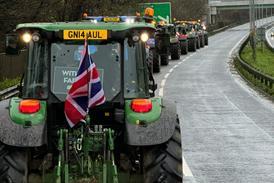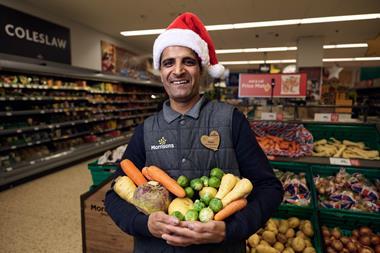Colin Smith, Chairman of Assured Food Standards, on the growth of Red Tractor Assurance
New research shows that 60% of own label fresh food in UK supermarkets now carries the red tractor. This accounts for more than £5bn every year, with strong indications that growth will continue. But why has the red tractor prevailed when competition for on-pack space is so high?
We've seen a steady increase in brand differentiation and a corresponding growth in niche brands and schemes. But how many will go the distance and how many can offer a fail-safe claim?
Of course, the tractor is not the only reliable mark on offer, but its independent, whole-chain status has broad appeal with a very wide audience.
There are three main reasons for the tractor's popularity:
First, the red tractor assurance scheme is unique in its governance. The scheme and its standards are not controlled by any one player, and there is no clear vested interest at any point of the supply chain. Instead, the independent, not-for-profit body that manages the scheme, Assured Food Standards, is owned jointly by trade bodies that span the whole UK supply chain.
This means that standards are set and continually reviewed by an equitable process, based not on competitive gain but on good science, market forces and practical common sense. Farmers, processors and retailers work together in a pre-competitive alliance - driving food standards forward but at a pace that supports a sustainable supply base.
The second pillar of the tractor's success is its wide portfolio of food types and its comprehensive farm-to-pack standards. Years of investment have yielded a single set of standards and inspections covering most farmed commodities and applying to all critical points of production.
Despite the challenge of uniting these different schemes and sectors, AFS has crafted a single symbol for assured food and in so doing has resolved the costly confusion that has been caused by multiple labels and claims.
With these credentials in place, the red tractor can focus on its third and most compelling attribute - its relevance to retailers and consumers.
Now with a clearly defined raison d'être, the logo has emerged as a single,trusted "kitemark" for assured production standards. The scheme, as a valuable industry watchdog, has resisted calls to absorb a broader, more political agenda and retained its core mandate - promoting the safe production of food with proper standards of animal welfare.
Furthermore, the tractor has established itself, not as a brand or a quality mark, but as a trusted validation of standards that sits comfortably beneath a wide range of commercial brands and quality claims.
Now with its wheels firmly in the retail environment, the tractor can respond to new consumer trends, penetrating new territories and opening doors for licensed suppliers.
This month, AFS released new licence criteria for further-processed foods, permitting the labelling of the 'principal ingredient' as a tractor product. There is widespread coverage on a growing list of brands; and, in other markets, there is interest from foodservice - giving rise to a special licence to use the tractor on menus.
Ironically, the only thing that hampers this growth is a limited budget for communications. The scheme has achieved its current status thanks to various campaigns by retailers and stakeholders. Recent efforts to revitalise the consumer message have yielded positive results.
But, with limited resources to sustain this activity, it may be short-lived. With extra investment from associates and levy bodies, the tractor could have a genuine opportunity to reconnect food businesses with their customers. Let's hope this new-found confidence will yield a collective commitment to fund its future as a major player in the reconnection agenda.
New research shows that 60% of own label fresh food in UK supermarkets now carries the red tractor. This accounts for more than £5bn every year, with strong indications that growth will continue. But why has the red tractor prevailed when competition for on-pack space is so high?
We've seen a steady increase in brand differentiation and a corresponding growth in niche brands and schemes. But how many will go the distance and how many can offer a fail-safe claim?
Of course, the tractor is not the only reliable mark on offer, but its independent, whole-chain status has broad appeal with a very wide audience.
There are three main reasons for the tractor's popularity:
First, the red tractor assurance scheme is unique in its governance. The scheme and its standards are not controlled by any one player, and there is no clear vested interest at any point of the supply chain. Instead, the independent, not-for-profit body that manages the scheme, Assured Food Standards, is owned jointly by trade bodies that span the whole UK supply chain.
This means that standards are set and continually reviewed by an equitable process, based not on competitive gain but on good science, market forces and practical common sense. Farmers, processors and retailers work together in a pre-competitive alliance - driving food standards forward but at a pace that supports a sustainable supply base.
The second pillar of the tractor's success is its wide portfolio of food types and its comprehensive farm-to-pack standards. Years of investment have yielded a single set of standards and inspections covering most farmed commodities and applying to all critical points of production.
Despite the challenge of uniting these different schemes and sectors, AFS has crafted a single symbol for assured food and in so doing has resolved the costly confusion that has been caused by multiple labels and claims.
With these credentials in place, the red tractor can focus on its third and most compelling attribute - its relevance to retailers and consumers.
Now with a clearly defined raison d'être, the logo has emerged as a single,trusted "kitemark" for assured production standards. The scheme, as a valuable industry watchdog, has resisted calls to absorb a broader, more political agenda and retained its core mandate - promoting the safe production of food with proper standards of animal welfare.
Furthermore, the tractor has established itself, not as a brand or a quality mark, but as a trusted validation of standards that sits comfortably beneath a wide range of commercial brands and quality claims.
Now with its wheels firmly in the retail environment, the tractor can respond to new consumer trends, penetrating new territories and opening doors for licensed suppliers.
This month, AFS released new licence criteria for further-processed foods, permitting the labelling of the 'principal ingredient' as a tractor product. There is widespread coverage on a growing list of brands; and, in other markets, there is interest from foodservice - giving rise to a special licence to use the tractor on menus.
Ironically, the only thing that hampers this growth is a limited budget for communications. The scheme has achieved its current status thanks to various campaigns by retailers and stakeholders. Recent efforts to revitalise the consumer message have yielded positive results.
But, with limited resources to sustain this activity, it may be short-lived. With extra investment from associates and levy bodies, the tractor could have a genuine opportunity to reconnect food businesses with their customers. Let's hope this new-found confidence will yield a collective commitment to fund its future as a major player in the reconnection agenda.














No comments yet